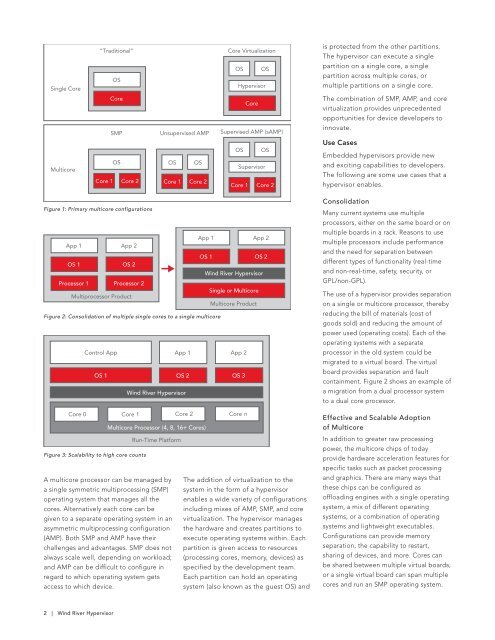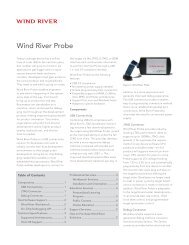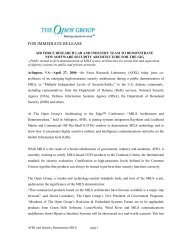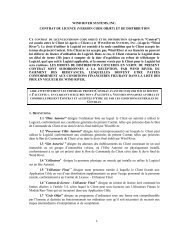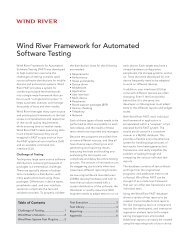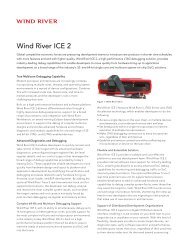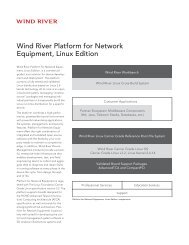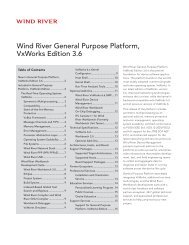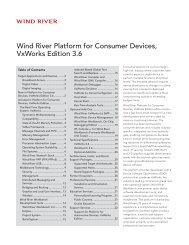Wind River Hypervisor
Wind River Hypervisor
Wind River Hypervisor
You also want an ePaper? Increase the reach of your titles
YUMPU automatically turns print PDFs into web optimized ePapers that Google loves.
Single Core<br />
Multicore<br />
A multicore processor can be managed by<br />
a single symmetric multiprocessing (SMP)<br />
operating system that manages all the<br />
cores. Alternatively each core can be<br />
given to a separate operating system in an<br />
asymmetric multiprocessing configuration<br />
(AMP). Both SMP and AMP have their<br />
challenges and advantages. SMP does not<br />
always scale well, depending on workload;<br />
and AMP can be difficult to configure in<br />
regard to which operating system gets<br />
access to which device.<br />
2 | <strong>Wind</strong> <strong>River</strong> <strong>Hypervisor</strong><br />
“Traditional”<br />
Core 1<br />
OS<br />
Core<br />
SMP<br />
OS<br />
Figure 1: Primary multicore configurations<br />
App 1<br />
OS 1<br />
Processor 1<br />
Unsupervised AMP<br />
Core 2 Core 1 Core 2<br />
App 2<br />
OS 2<br />
Processor 2<br />
Multiprocessor Product<br />
OS OS<br />
App 1<br />
OS 1<br />
Figure 2: Consolidation of multiple single cores to a single multicore<br />
Core 0<br />
Control App<br />
OS 1<br />
Run-Time Platform<br />
App 1<br />
OS 2<br />
<strong>Wind</strong> <strong>River</strong> <strong>Hypervisor</strong><br />
Core 1<br />
Figure 3: Scalability to high core counts<br />
Core 2<br />
Multicore Processor (4, 8, 16+ Cores)<br />
Core Virtualization<br />
OS OS<br />
<strong>Hypervisor</strong><br />
Core<br />
Supervised AMP (sAMP)<br />
OS OS<br />
Supervisor<br />
Core 1 Core 2<br />
Multicore Product<br />
App 2<br />
OS 2<br />
<strong>Wind</strong> <strong>River</strong> <strong>Hypervisor</strong><br />
Single or Multicore<br />
App 2<br />
OS 3<br />
Core n<br />
The addition of virtualization to the<br />
system in the form of a hypervisor<br />
enables a wide variety of configurations<br />
including mixes of AMP, SMP, and core<br />
virtualization. The hypervisor manages<br />
the hardware and creates partitions to<br />
execute operating systems within. Each<br />
partition is given access to resources<br />
(processing cores, memory, devices) as<br />
specified by the development team.<br />
Each partition can hold an operating<br />
system (also known as the guest OS) and<br />
is protected from the other partitions.<br />
The hypervisor can execute a single<br />
partition on a single core, a single<br />
partition across multiple cores, or<br />
multiple partitions on a single core.<br />
The combination of SMP, AMP, and core<br />
virtualization provides unprecedented<br />
opportunities for device developers to<br />
innovate.<br />
Use Cases<br />
Embedded hypervisors provide new<br />
and exciting capabilities to developers.<br />
The following are some use cases that a<br />
hypervisor enables.<br />
Consolidation<br />
Many current systems use multiple<br />
processors, either on the same board or on<br />
multiple boards in a rack. Reasons to use<br />
multiple processors include performance<br />
and the need for separation between<br />
different types of functionality (real-time<br />
and non-real-time, safety, security, or<br />
GPL/non-GPL).<br />
The use of a hypervisor provides separation<br />
on a single or multicore processor, thereby<br />
reducing the bill of materials (cost of<br />
goods sold) and reducing the amount of<br />
power used (operating costs). Each of the<br />
operating systems with a separate<br />
processor in the old system could be<br />
migrated to a virtual board. The virtual<br />
board provides separation and fault<br />
containment. Figure 2 shows an example of<br />
a migration from a dual processor system<br />
to a dual core processor.<br />
Effective and Scalable Adoption<br />
of Multicore<br />
In addition to greater raw processing<br />
power, the multicore chips of today<br />
provide hardware acceleration features for<br />
specific tasks such as packet processing<br />
and graphics. There are many ways that<br />
these chips can be configured as<br />
offloading engines with a single operating<br />
system, a mix of different operating<br />
systems, or a combination of operating<br />
systems and lightweight executables.<br />
Configurations can provide memory<br />
separation, the capability to restart,<br />
sharing of devices, and more. Cores can<br />
be shared between multiple virtual boards,<br />
or a single virtual board can span multiple<br />
cores and run an SMP operating system.


